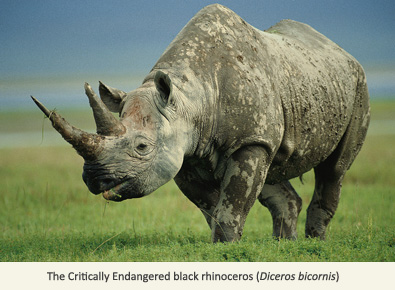Five eastern black rhinoceroses have recently been airlifted from the South African conservancy in which they were raised to Tanzania’s Serengeti National Reserve.
They are the first of 32 eastern black rhinos that are due to be returned to their native habitat following the evacuation of their ancestors almost 50 years ago – a time when the subspecies was on the verge of being wiped out by poaching.
Rhinos are poached primarily for their horns which are used in oriental medicine and can fetch huge prices on the black market.
Seven eastern black rhinos were translocated to South Africa in 1964, where they thrived in private game parks. Now their descendents are being returned in what has been described as the “most ambitious” international relocation of large mammals ever undertaken.
But has the threat from poaching subsided?
The short answer is no. Recent evidence suggests that poaching driven by increased Asian demand for rhino horn has soared in east Africa in the past five years. Six black rhinos were killed for their horns in neighboring Kenya in the last 12 months, and the authorities have had to put in place extreme measures to prevent Tanzania’s new arrivals from suffering the same fate.
An elite force of 24 rangers, drawn largely from the Tanzanian National Parks Authority, has been specially trained to monitor the rhinos, which will have GPS chips inserted in the horns so conservationists can track them.
Sadly, the situation is East Africa reflects a worrying global trend. Last December, conservationists reported that rhino poaching around the world is on the rise despite efforts to protect the animals. A report compiled by Traffic, the global wildlife trade monitoring network, and the International Union for Conservation of Nature (IUCN), with funding from WWF International suggested that the decline in law enforcement is the main reason for the rise in poaching in Africa.
The report found that 95% of rhino poaching in Africa since 2006 had occurred in Zimbabwe and South Africa.
Between 2006 and 2009, the report listed 210 [black and white] rhinos as being illegally killed in South Africa, with a further 235 being poached in Zimbabwe. The report added that poachers were now adopting much more sophisticated techniques such as veterinary drugs to kill their prey.
News just in from South African National Parks (SANParks) suggests that rhino poaching in South Africa has escalated even further since the beginning of the year, with 92 rhinos having been lost in the past five months alone.
The Kruger National Park is being particularly hard hit – 33 rhinos have been lost so far this year. The park is a stronghold for both black and white rhinos, being home to approximately 9,000 to 12,000 white rhinos of the approximately 19,000 strong population and between 580 and 650 black rhinos of the estimated country population of 1,670 black rhinos.
So far 25 suspected poachers have been arrested, with 17 having been arrested in the KNP, 5 in Gauteng and 3 in Mpumalanga Provinces.
SANParks is taking the losses very seriously. The army has returned to patrol the 300km eastern border of the park, hopefully making it more difficult for wildlife criminals to escape into neighboring countries. The Environmental Affairs Minister, Buyelwa Sonjica, has set up a National Wildlife Crime Reaction Unit (NWCRU) intended to deal with all environmental crimes in response to seriousness of the poaching scourge.
This unit consists of SAPS Organised Crime Unit, SANParks Environmental Crime Unit, the Provincial Conservation Anti-Poaching Unit and Prosecutors at a national and provincial level. The unit will function with extended powers to include the expertise of the National Director of Public Prosecution to fast track successful prosecution of suspects.
“This move by the Minister will also enable the various conservation agencies, including privately owned game reserves, to populate poaching incident reports and allow for accurate national poaching statistics, something that is key to the appropriate management and eventual reduction of this problem.”
This move should help South Africa to identify problematic areas more effectively and direct resources accordingly.
Dr David Mabunda, Chief Executive Officer at SANParks, added “We are dealing here with organized crime and hardened criminals linked to notorious syndicates that the SAPS and Interpol are also looking for. We know that our combined efforts will reap fruitful results in the near future and SANParks stays committed to making every effort to wipe-out this assault that is threatening our natural heritage.”
Four of the five rhinoceros species occupy spots on the top 100 EDGE mammals list because of their combination of extreme evolutionary distinctiveness and threatened status. As demand for rhino horn and subsequent poaching increases throughout their ranges, we must step up to protect these magnificent animals for generations to come.
